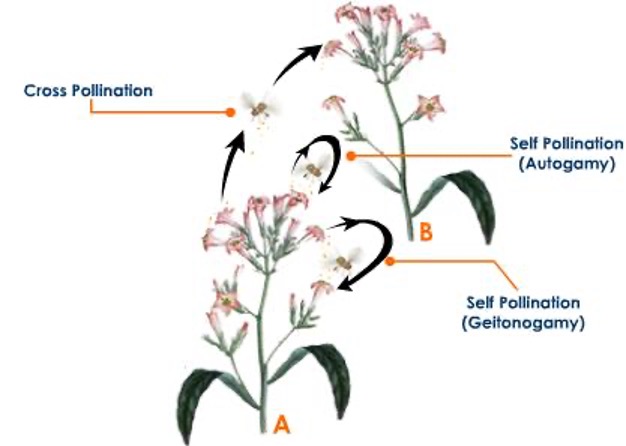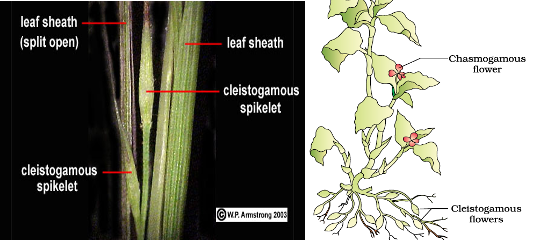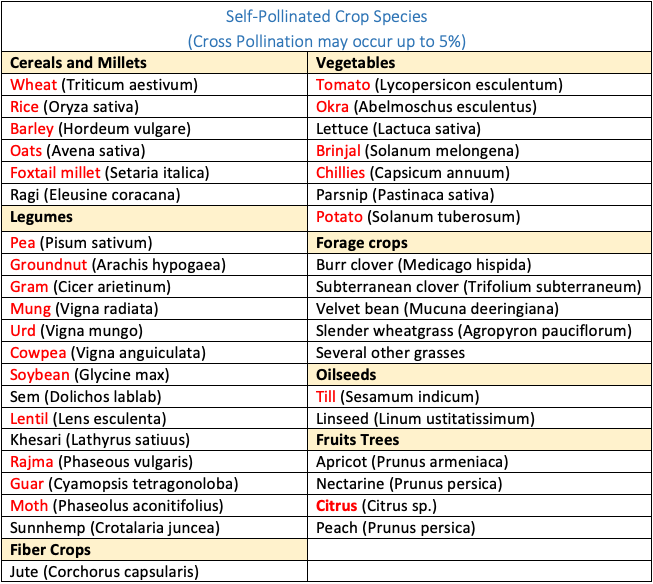🕊 Pollination
Types, Mechanisms promoting Self & Cross Pollination

- Study of pollen grain is termed as
Palynology. - Pollen grain is a double walled structure, with hard outer cover (exine) and thin inner layer (intine).
Self-pollination (Autogamy)
- In such pollination, pollen from an anther falls on the stigma of the same flower.
- Cross pollination is less than 5 %.
- Self-pollination leads to rise in
homozygosity.
Cross-Pollination
Geitonogamy
- When pollens from a flower of one plant fall on the stigmas of
other flowersof thesame plant, this situation is called geitonogamy. - The genetic consequence of geitonogamy is the same as those of
autogamy.
Allogamy
- Here pollens from flowers of the one plant are transmitted to the stigma of flowers of
another plantby wind (anemophily), water (hydrophily) or insects (entomophily). - Allogamy leads to rise in
heterozygosity.

Mechanisms promoting self-pollination
- Cleistogamy: Here
Flowers do not openat all i.e. complete closed flowers. e.g. some varieties of wheat, oat, barley and in some grasses. - Chasmogamy: Here Flowers
open only after pollination. Due to opening of flower, some cross pollination may occur.
- In some crops stigma is closely surrounded by anthers and pollination generally occurs when the flowers open E.g. Tomato, Brinjal.
- In some species, the flowers open but the stamens and stigma are hidden by the floral organs. E.g. pea, mung, urd, soybean, gram.
- In few species, the stigma becomes receptive and elongates through the staminal columns.

Classification of crop species on the basis of their natural mode of pollination
Self-Pollinated Crop Species

Cross-Pollinated Crop Species

Often Cross-Pollinated Crops

Genetic makeup of often cross pollinated plants is intermediate between self-pollinated and cross-pollinated plants.
Mechanism promoting cross-pollination
Dicliny or unisexuality
- Dicliny or unisexuality is a condition in which the flowers are either staminate (male) or pistillate (female).
- It is of two types
Monoecy
- Staminate & Pistillate flowers are found in the
same planteither in the same inflorescence or in separate inflorescences. - Examples of same inflorescence:
Castor,Mango,Banana&Coconut - Examples of different inflorescences:
Maize
Dioecy
- Staminate (♂) & pistillate (♀) flowers are found on
different plants. - E.g.
Papaya,Dates, Hemp, Asparagus, Spinach.
Dichogamy
- Maturity times of stamens and pistils of hermaphrodite flowers are different.
- Protogyny: Here
pistilsmature earlier than stamens. E.g. Bajra - Protoandry: Here
stamensmature earlier than pistils E.g. Maize, Sugarbeet
Duodichogamy
🔖 RRB-SO 2020
- A temporal mating system in which each plant produces two batches of male flowers that are temporally separated by a batch of female flowers, with within-individual synchrony and among-individual asynchrony to ensure mating partners.
- Most trees flower in the order male → female → male.
- Duodichogamy is a rarest form of dichogamy, it is known only in a few species in four genera in unrelated families.
Other
- In some plants, stigma is covered with a waxy film which is broken by the visit of honey bees facilitating cross pollination. E.g. Lucerne or alfalfa.
- More than one mechanism may occur in some species. e.g. maize has both monoecy and protoandry.
- Self Incompatibility: means the failure of pollen from a flower to fertilize the same flower or other flowers on the same plant. Here male gamete is fully functional. E.g. Brassica sp., Nicotiana, radish etc.
- Male Sterility: means the
non-functionalpollen grains. Here female gamete is fully functional. Male sterility is not common in natural populations.
Self-Incompatibility
- Self-incompatible pollen grain does not germinate and if pollen grain germinates, its pollen tube fails to enter into stigma. If pollen tube enters into stigma and fertilization takes place but ultimately embryo aborts. It means any how embryo does not develop and occurrence of self-incompatibility is due to biochemical reaction but its precise nature is not clearly understood.
- On the basis of the interaction between pollen grains and pistil, it is of two types:
- Complementary i.e. stimulatory type where pistil & pollen stimulate each other or either. e.g. Dendrobium.
- Oppositional i.e. inhibitory type where pistil & pollen inhibit each other or either. Almost all the cases of self-incompatibility are inhibitory type.
- Lewis (1954) suggested various types of classifications of self-incompatibility (SI). A simpler classification is:
Heteromorphic System
- Flowers of different incompatibility groups are different in morphology.
- The compatibility reaction of pollen is determined by the genotype of the plant producing them. The incompatibility system is heteromorphic-sporophytic.
Homomorphic System
- Here morphological differences between flowers is not associated with incompatibility. The incompatibility reaction of pollen is either controlled by the genotype of the plant on which it is produced (sporophytic control) or by its own genotype (gametophytic control).
- Gametophytic system: East and Mangelsdorf (1925) firstly described Gametophytic incompatibility in Nicotiana sanderae. The incompatibility reaction of pollen is determined by its own genotype and not by the genotype of the plant on which it is produced. e.g. pineapple, ryegrass, diploid coffee, diploid clovers (Trifolium sp.) etc.
- Sporophytic system: First time this system was reported, by Hughes & Babcock (1950) in Crepis foetida and by Gerstel (1950) in Parthenium argentatum. The incompatibility reaction of pollen is determined by the genotype of the plant on which the pollen is produced and not by the genotype of the pollen.
Elimination of self-incompatibility
- By doubling the chromosome number in single locus gametophytic system.
- Isolation of self-fertile mutations (very useful tool)
- The transfer of self-compatibility alleles from a related species through a back cross programme.
Temporary suppression of self-incompatibility
- For the production of inbred (for hybrid seed production) it is essential to achieve self-fertility, where self-incompatibility is fully functional in the selfed progeny. This self-fertility is called as pseudo fertility. This pseudo fertility is achieved through temporary suppression of incompatibility by one of the following techniques:
- Bud pollination: Means application of mature pollen to immature non-receptive stigma generally 1-2 days before anthesis. Bud pollination is the most practicable & successful method in both gametophytic and sporophytic systems.
- Surgical techniques: Removal of stigma is very useful in sporophytic system. Pollen is directly dropped on to the ovules.
- End-of-season pollination controversial technique.
- High temperature: May induce pseudo fertility E.g. in Trifolium, Lycopersicon, Brassica, Oenothera exposure of pistils upto 60°C induces pseudo fertility.
- Increased CO2 conc. in sporophytic system
- High humidity
- Salt, (NaCl) sprays are used by the Chinese
- Irradiation: In a single locus gametophytic system. e.g. in solanaceae, acute irradiation with x-rays or γ-rays induces pseudo-fertility
- Grafting
- Double pollination
- Other techniques like use of phytohormones, treatment of flowers with carbon-monoxide etc.
Male Sterility
- Male sterility means
non-functionalpollen grains. Here female gametes are normally functional. It is classified into four groups: - Genetic Male Sterility (GMS) or Nuclear Male Sterility
- Temperature-sensitive GMS
- Photoperiod-sensitive GMS
- Transgenic GMS
- Cytoplasmic Male Sterility (CMS)
- Cytoplasmic-Genetic Male Sterility (CGMS)
- Chemically-Induced Male Sterility
- Male Sterility is used for hybrid seed production in many crops because it is a means of genetic emasculation. UPPSC 2021
Genetic (Nuclear) Male Sterility
- GMS/NMS is ordinarily governed by a single recessive gene
msbut also by dominant genes. Male sterility alleles are occurred spontaneously or are induced artificially. - Genetic male sterility is simple and ecofriendly technique of hybrid seed production. UPPSC 2021
- When a male sterile plant (ms ms) is crossed with the male fertile (Ms Ms) plant, the product F1 (Ms ms) is male fertile.
- In F2, 3 Fertile : 1 Sterile is obtained. A male sterile line is maintained by crossing with heterozygous male fertile (Ms ms). This mating produces 1 : 1 male sterile & male fertile plants.
Maintenance of a male sterile line
- During the maintenance of male sterile lines, sibmating (i.e. brother-sister mating) is achieved through natural pollination.
- In some cases ms gene expression is affected by the specified range of temperature and or photoperiod regime. Such GMS is environment sensitive and found in Rice, tomato, wheat etc.
- Temperature-sensitive Genetic Male sterility:
- Complete male sterility is produced by the ms gene at higher temperatures
- E.g. 23.3°C or higher for rice TGMS line Pei-Ai 645. This type of genetic male sterility is being used in the China to develop hybrid rice.
- Photoperiod-sensitive Genetic male sterility (PGMS):
- In some cases, ms gene expression is drastically affected by the prevailing photoperiod, provided the temp. is within the critical range.
- E.g. the critical temp. is 23-29° C for rice for PGMS. Within this critical temp. range, complete sterility is found in rice plants grown under long day conditions (i.e. day length more than 13 hours 45 minutes). But under short day conditions almost normal fertility is found. This type PGMS is being utilized in the China to develop hybrid rice.
Transgenic Genetic male sterility
- Transgene is such a gene which is introduced into the genome of an organisms by recombinant DNA technology or genetic engineering. Many transgenes cause male sterility. These are found in maize, cauliflower, tomato, wheat & chicory but this system is not yet used commercially.
- The genetic male sterility is being used for hybrid rice development in China. GMS is being successfully used in castor in U.S.A. In India GSM is being used for hybrid seed production of Arhar by private companies like Maharashtra Hybrid seed Co. Ltd.
Cytoplasmic Male Sterility (CMS)
- Here male sterility is governed by the cytoplasm. The male sterility is the result of mutation in the mitochondrial genome (mt DNA) which leads to mitochondrial dysfunction e.g. CMS-Maize, Ogura cms of brassica.
- Since the cytoplasm of a zygote comes primarily from egg cells, the progeny of such male sterile plants would always be male sterile.
- Cytoplasmic male sterility may be transferred easily to a given strain by using that strain as a pollinator (recurrent parent) in the, successive generations of a backcross programme.
- CMS is used only for the vegetative growth purposes because all the progenies are male steriles & there are no seed setting.
- It is used in chillies by some private companies.
- In 1996, Kaul concluded that restorer genes have been detected for all cases of CMS. The idea of CMS has been disfavored by Kaul and according to Kaul, male sterility is either genetic or cytoplasmic-genetic.
Cytoplasmic-genetic male sterility (CGMS)
- The case of cytoplasmic male sterility where the nuclear gene for restoring fertility in the male sterile line is known; is called cytoplasmic genetic male sterility.
- The fertility restorer gene, R, is dominant which restores male fertility in the male sterile line. If the nuclear genotype is rr, and the cytoplasm is male sterile, then plant would be male sterile.
- The effect of sterile cytoplasm is negated by the presence of restorer gene R even in heterozygous condition (Rr) because R is dominant over r.
- CGMS is also known as nucleoplasmatic male sterility.
- CGMS is commercially utilized in rice, wheat, maize, Sorghum, Perl Millet, Cotton etc.
- After selfing of the male fertile progeny, individual plant progeny is grown in the next generation and non-segregating progenies are selected and segregating progenies are rejected.
- Determination of genotype or genotypic value of a plant by studying its progeny is known as progeny test.
Chemical hybridising Agent (CHA)
- Such chemicals which affect the function of male reproductive organs in plants; are called chemical hybridising agents (CHAs).
- E.g.
Maleic hydrazide(MH),α - NAA,β - NAA, FW 450 (Mendok),Ethrel (Ethephon),Arsenicals, GA3, Hybrex (RH0007), Shell (WL 84811). Firstly in 1950, Moore & Naylor induced male sterility in maize using MN. - Hybrex has been used for the commercial production of hybrid wheat in USA since 1982.
- Arsenic inhibits respiration in anthers via enzymes like succinate dehydrogenase and cytochrome oxidase.
- Ethephon (Ethrel) produces ethylene which interacts with the plant hormone system.
- GA produces male sterility in rice, wheat etc. by interfering with tile nutrient flow to developing anthers.
- Hybrex disrupts pollen development during microsporogenesis which leads to irregular and thinner deposition of exine and ultimately to pollen

- Study of pollen grain is termed as
Palynology. - Pollen grain is a double walled structure, with hard outer cover (exine) and thin inner layer (intine).
Self-pollination (Autogamy)
- In such pollination, pollen from an anther falls on the stigma of the same flower.
- Cross pollination is less than 5 %.
- Self-pollination leads to rise in
homozygosity.
Cross-Pollination
Geitonogamy
- When pollens from a flower of one plant fall on the stigmas of
other flowersof thesame plant, this situation is called geitonogamy. - The genetic consequence of geitonogamy is the same as those of
autogamy.
Allogamy
- Here pollens from flowers of the one plant are transmitted to the stigma of flowers of
another plantby wind (anemophily), water (hydrophily) or insects (entomophily). - Allogamy leads to rise in …
Become Successful With AgriDots
Learn the essential skills for getting a seat in the Exam with
🦄 You are a pro member!
Only use this page if purchasing a gift or enterprise account
Plan
₹
- Unlimited access to PRO courses
- Quizzes with hand-picked meme prizes
- Invite to private Discord chat
- Free Sticker emailed
Lifetime
₹
9,999
once
- All PRO-tier benefits
- Single payment, lifetime access
- 4,200 bonus xp points
- Next Level
T-shirt shipped worldwide

Yo! You just found a 20% discount using 👉 EASTEREGG

High-quality fitted cotton shirt produced by Next Level Apparel